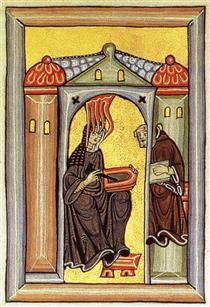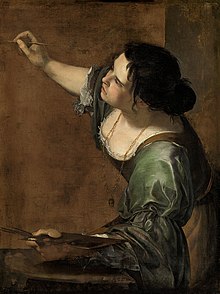 |
| Hildegaurd of Bingen; Scivias, 1442-52 |
Jenna Arvelo
The Middle Ages was not particularly a welcoming era for women kind anywhere, with that being said it’s safe to say it must have been incredibly vexing to have lived as a woman of the Middle Ages. To be of the fairer sex in this period of time meant that you virtually had no rights or freedom for themselves. They could not own land, they could not earn money, they could not own anything really and were basically owned by either their fathers or their husbands. As the Guerrilla Girls quote: “Women were the virtual prisoners to the men in their lives” [Guerrilla Girls; chapter 2, page 19] The role of the Middle Age woman was of course centered around marriage and motherhood literally as soon as a girls’ body could produce children. Meaning their childhoods were often abruptly cut short because of their gender assigned obligations. It also didn’t help that the Bible basically set these women up to take the blame for the fall of all mankind. This was also often the justification for the belittlement of women from all walks of life.
Although, women did have roles in which they could be unshackled from the burdens of domestication. Nun-hood was the perfect way women could be educated, avoid marriage. Yet the Catholic Church was still none the less a patriarchal system that deemed women inferior; as Chadwick quotes: “The Church’s hierarchical organization reinforced the class distinctions in society; it’s patriarch dogma included a full set of theories on the natural inferiority of women which can be traced back to Ancient Greece and the Old Testament.” [Chadwick; chapter one, page 44] Although the boundaries were clearly distinguished for women nun-hood was again an opportunity for an education and to be free of the societal predators that were the men trying to court them, it was a system they could also rise to power within. One of the best and most impressive examples of this is Herrad of Landsberg who held immense power and presence for a women of her time and dedicated Hortus Deliciarum to the nuns of her convent. A passage from from Chadwick that conveys this; “Herrad, who through the grace of God is abbess of the church on the Hohenburg, here addresses the sweet maidens of Christ....I was thinking of your happiness when like a bee guided by the inspiring God I drew from many flowers of sacred and philosophic writing this book called Garden of Delights; and I have put it together to the praise of Christ and the church, and your enjoyment, as though into a sweet honeycomb....”. [Chadwick; chapter 1, page 56] Another amazing women who rose to power through the convent was Hildegard of Bingen who also created manuscripts and was highly revered and respected.
 |
| Artemisia Gentileschi; Self-Portrait as the Allegory of Painting, 1630's |
Work Cited
~The Guerrilla Girls' Bedside Companion to the History of Western Art by The Guerrilla Girls
~Women, Art, and Society by Whitney Chadwick (4th edition, 2007) Thames and Hudson world of art
No comments:
Post a Comment
Note: Only a member of this blog may post a comment.